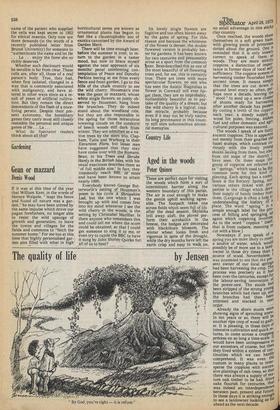Gardening
Gean or mazzard
Denis Wood
If it was at this time of the year that William Kent, in the words of Horace Walpole, "leapt the fence; and found all nature was a garden," he may have been stirred by the same impulse which drove our pagan forefathers, no longer able to resist the wild upsurge of growth and generation, to leave the towns and villages for the fields and commons to "fetch the, summer home." For me too at this time that highly personalised garden plot filled with what in high! horticultural terms are known as ornamental plants has begun to feel like a claustrophobic zoo of exotics canonised by the Award of Garden Merit.
There will be time enough later, before the summer is over, to return to the garden in a tamer mood, but now to brace myself against the near approach of six months' penal unrelenting con-. templation of Peace and Dorothy Perkins leering at me from every, fence and front garden, I go to the hills of the chalk country to see the wild cherry. Housman's tree was the gean or mazzard, whose white single flowers, as justly ob-' served by Housman, hang from the branches. They do indeed stand about the woodland ride, but they are also responsible in the spring for those miraculous towering clouds on the outskirts' of beech woods still dark fr-om' winter, They are admitted as a native trees by the stern -trio, Clapham, Tutin and Warburg in their, Excursion Flora, but lesser men have suggested that they may have come over with the Romans. Bean, in his Trees and Shrubs Hardy in the British Isles, with his usual exactness describes them as 'of full middle size.' In fact, they
commonly. reach 60ft. more' and and have been known to attain nearly 100ft.
Everybody knows George Butterworth's setting of Housman's poem in his Cycle .-A-Sh-ropshire Lad, but the one which I was brought up with and comes first into my mind whenever I see the wild cherry in the woods, is the setting by Christabel Marillier. Is' there anyone who remembers this and could tell me where the score could be obtained, so that I could get someone to sing it to me, or even try to cajole the BBC to have it sung by John Shirley-Quirke fori
all of us to hear? _
Its lovely single flowers are fugitive and too often blown away by the gales of spring. For this reason and because the whiteness of the flower is denser, the double, flowered version is probably better for gardens. It has been known for two centuries and presumably arose as a sport from the common tean. Beandescribed this as one of the most beautiful of all flowering trees and, for me, this is certainly true. There are trees with more spectacular flowers; no one who has seen the Asiatic -Magnolias in flower in Cornwall will ever forget them, they are so improbably, outlandishly beautiful as to partake of the quality of a dream; but the wild cherry is a logical, credible miracle, probably because even if it may not be truly native, its long provenance in this country still stirs subconscious ancestral memories.


































 Previous page
Previous page